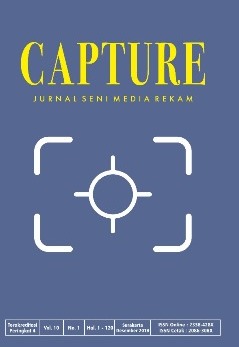APROPRIATION OF METAFORA IN FILM ADVERTISING “MANDIRI SECURITAS”
DOI:
https://doi.org/10.33153/capture.v10i1.2181Keywords:
rhetoric, metaphora, advertising film, banking, krisAbstract
Mandiri Securitas Advertising Film is an advertising film using the rhetoric strategy of visual communication of the kris masters as a creative approach. The theme as a basic idea for the creation of the Mandiri Securitas advertisement film seeks to understand the effort of working hard to produce details from the master's work to produce a keris blade, created with metaphorical rhetoric to represent the image of Mandiri Securitas in serving its customers whether they can work well or not by looking at each the role of the political rhetoric domain and banking rhetoric in both. The purpose of this study was to critically identify the two domain metaphorical rhetoric by looking at each role of the constituent elements of the Mandiri Securitas advertising film. This research method uses descriptive qualitative deconstruction by "appropriation minus one" technique through the dismantling of the banking domain and the domain of perkerisan to see the position of the filmmatic metaphorical rhetoric of the Mandiri Securitas  advertisement. Advertising films contain constituent elements such as visual, audio, animated effects and voice over that support the formation of advertising metaphors. Through appropriation "minus one" can be found the position of visual rhetoric of the keris domain is able to deliver messages from products desired by Mandiri Securitas , but if "animated text" and "voice over" are removed, there is no rhetorical relationship in both.
Downloads
References
Ann Marie Barry, 2004. Perception Theory from: Handbook of Visual Communication,Theory, Methods, and Media, USA: Routledge
Edward F. Mcquarrie, David Glen Mick, Visual Rhetoric in Advertising: Text-Interpretive, Experimental, and Reader-Response Analyses, ( Jounal of Consumer Research, Inc. • Vol. 26 • June 1999)
Lakoff, George dan Johnson, Mark. 2003. Metaphor We Live by. Chicago: The University of Chicago.
Sutopo, HB. 2006. Metodologi Penelitian Kualitatif, Dasar teori dan terapanya dalam penelitian. Penerbit: Universitas Sebelas Maret Surakarta, Surakarta.
Soedarsono, R.M. 1999. Metodologi Seni Pertunjukkan dan Seni Rupa, Bandung: MSPI
Pertti Alasututari, 1995. Research culture, Quallitative Method And Cultural Studies, London: Sage Publictions Ltd.
Wahyu Wibowo, 2003. Sihir Iklan, Format komunikasi mondial dalam kehidupan urban kosmopolit, Jakarta: Gramedia Pustaka.
https://www.youtube.com/channel/UCsy__Nh0Eh7f6NTMAzvPamA/videos, diakses 04/09/2018
https://www.youtube.com/watch?v=1d4OLynmIIo, diakses 01/09/2018
https://twp.duke.edu/sites/twp.duke.edu/files/file-attachments/overview-vis.original.pdf, diakses 12 Januari 2018.
Downloads
Published
Issue
Section
License
Copyright (c) 2019 Handriyo topo, GR Lono Lastoro, SP Gustami

This work is licensed under a Creative Commons Attribution-ShareAlike 4.0 International License.
Copyright
Authors who publish with Capture: Jurnal Seni Media Rekam agree to the following terms:
- Authors retain copyright and grant the journal right of first publication with the work simultaneously licensed under a Creative Commons Attribution License (CC BY-SA 4.0) that allows others to share the work with an acknowledgment of the work's authorship and initial publication in this journal.
- Authors are able to enter into separate, additional contractual arrangements for the non-exclusive distribution of the journal's published version of the work (e.g., post it to an institutional repository or publish it in a book), with an acknowledgment of its initial publication in this journal.







